2014 NISSAN GT-R wheel
[x] Cancel search: wheelPage 320 of 354
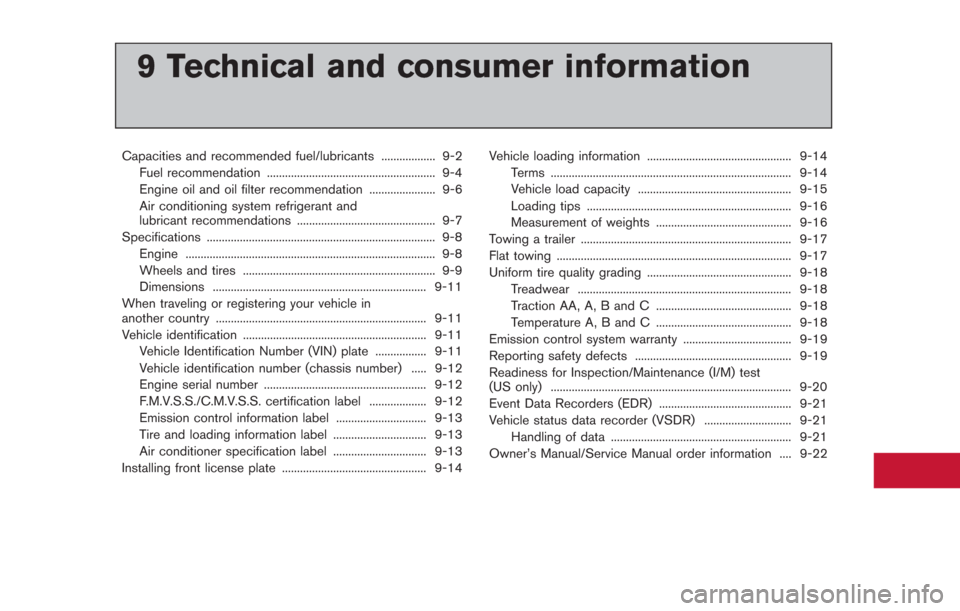
9 Technical and consumer information
Capacities and recommended fuel/lubricants .................. 9-2Fuel recommendation ........................................................ 9-4
Engine oil and oil filter recommendation ...................... 9-6
Air conditioning system refrigerant and
lubricant recommendations .............................................. 9-7
Specifications ........................................................................\
.... 9-8
Engine ........................................................................\
........... 9-8
Wheels and tires ................................................................ 9-9
Dimensions ....................................................................... 9-11
When traveling or registering your vehicle in
another country ...................................................................... 9-11 Vehicle identification ............................................................. 9-11 Vehicle Identification Number (VIN) plate ................. 9-11
Vehicle identification number (chassis number) ..... 9-12
Engine serial number ...................................................... 9-12
F.M.V.S.S./C.M.V.S.S. certification label ................... 9-12
Emission control information label .............................. 9-13
Tire and loading information label ............................... 9-13
Air conditioner specification label ............................... 9-13
Installing front license plate ................................................ 9-14 Vehicle loading information ................................................ 9-14
Terms ........................................................................\
........ 9-14
Vehicle load capacity ................................................... 9-15
Loading tips .................................................................... 9-16
Measurement of weights ............................................. 9-16
Towing a trailer ...................................................................... 9-17
Flat towing ........................................................................\
...... 9-17
Uniform tire quality grading ................................................ 9-18 Treadwear ....................................................................... 9-18
Traction AA, A, B and C ............................................. 9-18
Temperature A, B and C ............................................. 9-18
Emission control system warranty .................................... 9-19
Reporting safety defects .................................................... 9-19
Readiness for Inspection/Maintenance (I/M) test
(US only) ........................................................................\
........ 9-20
Event Data Recorders (EDR) ............................................ 9-21
Vehicle status data recorder (VSDR) ............................. 9-21 Handling of data ............................................................ 9-21
Owner’s Manual/Service Manual order information .... 9-22
Page 328 of 354
![NISSAN GT-R 2014 R35 Owners Manual WHEELS AND TIRES
Tire
TypeSize Pressure PSI (kPa) [Cold]
Summer Front: 255/40ZRF20 (97Y)
29 (200)
Rear: 285/35ZRF20 (100Y)
All-season Front: 255/40RF20 97W
29 (200)
Rear: 285/35RF20 100W
Make sure to NISSAN GT-R 2014 R35 Owners Manual WHEELS AND TIRES
Tire
TypeSize Pressure PSI (kPa) [Cold]
Summer Front: 255/40ZRF20 (97Y)
29 (200)
Rear: 285/35ZRF20 (100Y)
All-season Front: 255/40RF20 97W
29 (200)
Rear: 285/35RF20 100W
Make sure to](/manual-img/5/368/w960_368-327.png)
WHEELS AND TIRES
Tire
TypeSize Pressure PSI (kPa) [Cold]
Summer Front: 255/40ZRF20 (97Y)
29 (200)
Rear: 285/35ZRF20 (100Y)
All-season Front: 255/40RF20 97W
29 (200)
Rear: 285/35RF20 100W
Make sure to use the specific tires for GT-R. See the 2014 Warranty Information Booklet for the
applicable exclusions. Refer to the following table for the details of applicable tires.
Summer tire
All-season tire Winter tire
DUNLOP SP
SPORT MAXX GT
600 DSST CTT DUNLOP SP
SPORT
600 DSST BRIDGESTONE
POTENZARE070R
(without “R2” mark) BRIDGESTONE
POTENZARE070R
(with “R2” mark) DUNLOP SP
SPORT 7010 DUNLOP SP
SPORT WINTER 3D DSST CTT
666*
◎: Applicable as a standard or option
6: Not applicable
*: GT-R specified tire recommended by a GT-R certified NISSAN dealer
PRECAUTIONS FOR TIRE REPLACEMENT
. Use “DUNLOP SP SPORT MAXX GT 600
DSST CTT” tires for 2014 model year
NISSAN GT-R.
. “DUNLOP SP SPORT 600 DSST” tires and
any BRIDGESTONE tires cannot be used.
Contact your GT-R certified NISSAN dealer to
obtain information regarding the best replace-
ment tire for your model GT-R.
Technical and consumer information9-9
Page 329 of 354
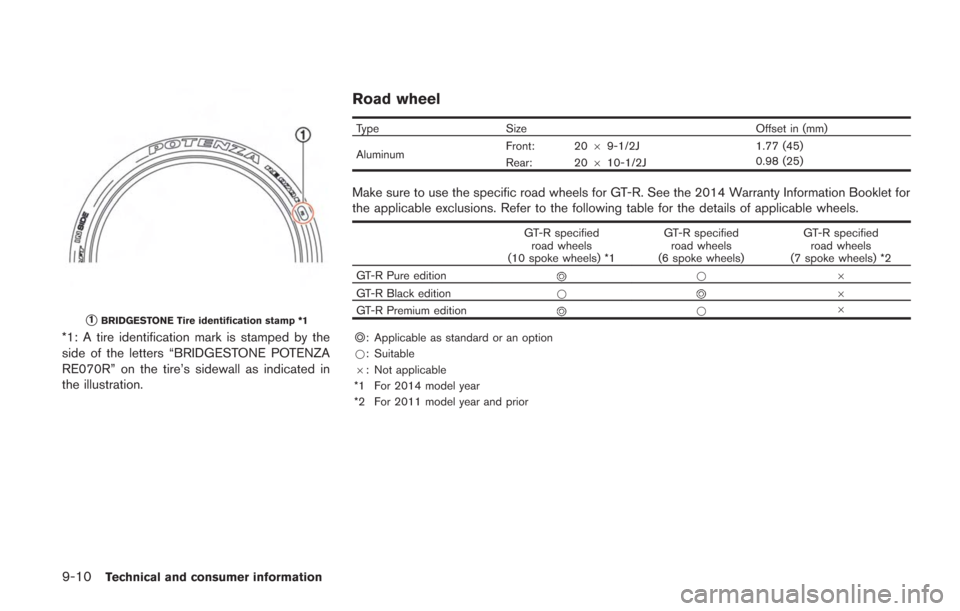
9-10Technical and consumer information
*1BRIDGESTONE Tire identification stamp *1
*1: A tire identification mark is stamped by the
side of the letters “BRIDGESTONE POTENZA
RE070R” on the tire’s sidewall as indicated in
the illustration.
Road wheel
Type Size Offset in (mm)
Aluminum Front: 20
69-1/2J 1.77 (45)
Rear: 20 610-1/2J 0.98 (25)
Make sure to use the specific road wheels for GT-R. See the 2014 Warranty Information Booklet for
the applicable exclusions. Refer to the following table for the details of applicable wheels.
GT-R specified
road wheels
(10 spoke wheels) *1 GT-R specified
road wheels
(6 spoke wheels) GT-R specified
road wheels
(7 spoke wheels) *2
GT-R Pure edition
* 6
GT-R Black edition *
6
GT-R Premium edition
* 6
◎: Applicable as standard or an option
*: Suitable
6: Not applicable
*1 For 2014 model year
*2 For 2011 model year and prior
Page 330 of 354
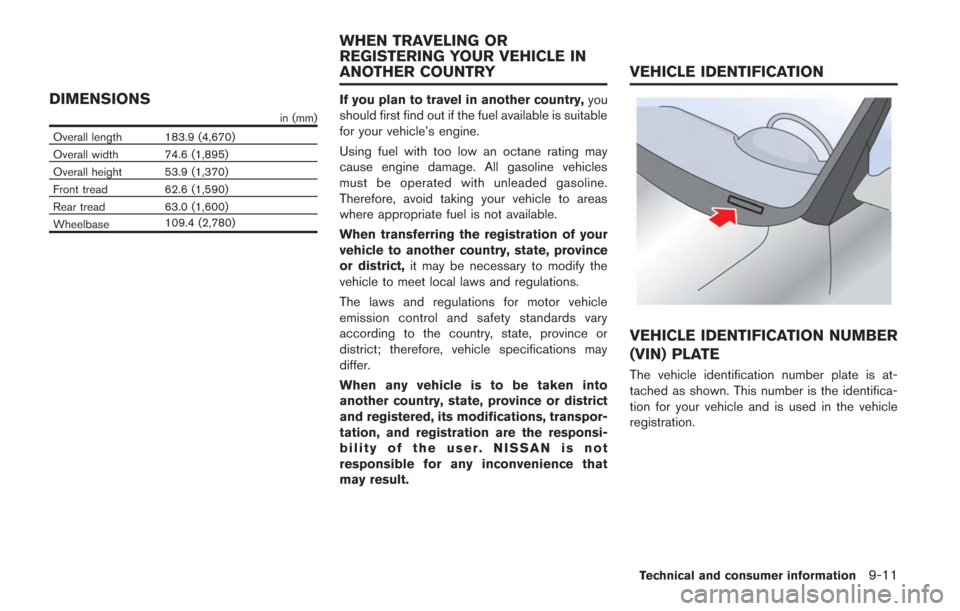
DIMENSIONS
in (mm)
Overall length 183.9 (4,670)
Overall width 74.6 (1,895)
Overall height 53.9 (1,370)
Front tread 62.6 (1,590)
Rear tread 63.0 (1,600)
Wheelbase 109.4 (2,780)
If you plan to travel in another country,
you
should first find out if the fuel available is suitable
for your vehicle’s engine.
Using fuel with too low an octane rating may
cause engine damage. All gasoline vehicles
must be operated with unleaded gasoline.
Therefore, avoid taking your vehicle to areas
where appropriate fuel is not available.
When transferring the registration of your
vehicle to another country, state, province
or district, it may be necessary to modify the
vehicle to meet local laws and regulations.
The laws and regulations for motor vehicle
emission control and safety standards vary
according to the country, state, province or
district; therefore, vehicle specifications may
differ.
When any vehicle is to be taken into
another country, state, province or district
and registered, its modifications, transpor-
tation, and registration are the responsi-
bility of the user. NISSAN is not
responsible for any inconvenience that
may result.
VEHICLE IDENTIFICATION NUMBER
(VIN) PLATE
The vehicle identification number plate is at-
tached as shown. This number is the identifica-
tion for your vehicle and is used in the vehicle
registration.
Technical and consumer information9-11
WHEN TRAVELING OR
REGISTERING YOUR VEHICLE IN
ANOTHER COUNTRY VEHICLE IDENTIFICATION
Page 335 of 354
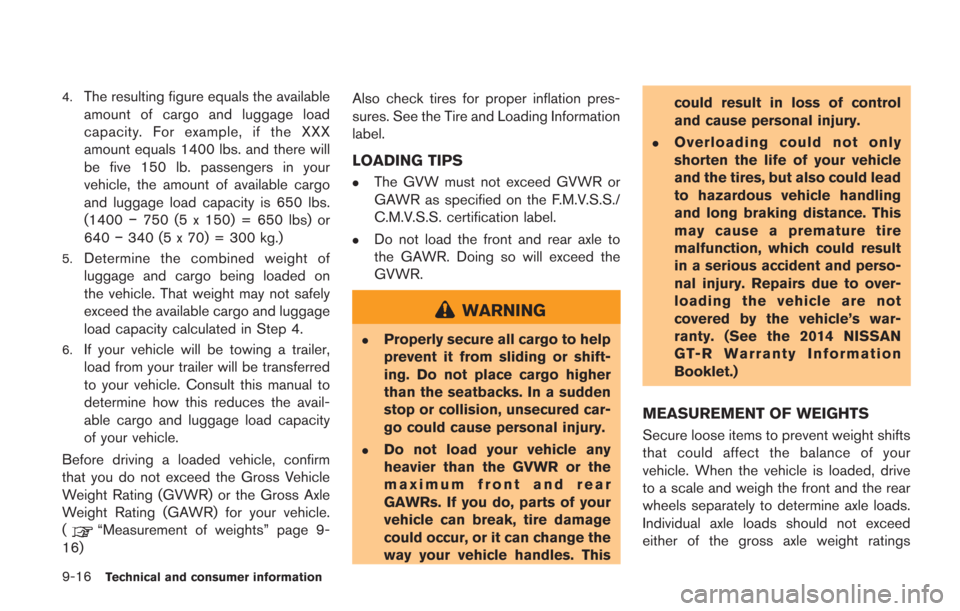
9-16Technical and consumer information
4.The resulting figure equals the available
amount of cargo and luggage load
capacity. For example, if the XXX
amount equals 1400 lbs. and there will
be five 150 lb. passengers in your
vehicle, the amount of available cargo
and luggage load capacity is 650 lbs.
(1400−750 (5 x 150) = 650 lbs) or
640 −340 (5 x 70) = 300 kg.)
5.Determine the combined weight of
luggage and cargo being loaded on
the vehicle. That weight may not safely
exceed the available cargo and luggage
load capacity calculated in Step 4.
6.If your vehicle will be towing a trailer,
load from your trailer will be transferred
to your vehicle. Consult this manual to
determine how this reduces the avail-
able cargo and luggage load capacity
of your vehicle.
Before driving a loaded vehicle, confirm
that you do not exceed the Gross Vehicle
Weight Rating (GVWR) or the Gross Axle
Weight Rating (GAWR) for your vehicle.
(
“Measurement of weights” page 9-
16) Also check tires for proper inflation pres-
sures. See the Tire and Loading Information
label.
LOADING TIPS
.The GVW must not exceed GVWR or
GAWR as specified on the F.M.V.S.S./
C.M.V.S.S. certification label.
.Do not load the front and rear axle to
the GAWR. Doing so will exceed the
GVWR.
WARNING
.Properly secure all cargo to help
prevent it from sliding or shift-
ing. Do not place cargo higher
than the seatbacks. In a sudden
stop or collision, unsecured car-
go could cause personal injury.
.Do not load your vehicle any
heavier than the GVWR or the
maximum front and rear
GAWRs. If you do, parts of your
vehicle can break, tire damage
could occur, or it can change the
way your vehicle handles. Thiscould result in loss of control
and cause personal injury.
.Overloading could not only
shorten the life of your vehicle
and the tires, but also could lead
to hazardous vehicle handling
and long braking distance. This
may cause a premature tire
malfunction, which could result
in a serious accident and perso-
nal injury. Repairs due to over-
loading the vehicle are not
covered by the vehicle’s war-
ranty. (See the 2014 NISSAN
GT-R Warranty Information
Booklet.)
MEASUREMENT OF WEIGHTS
Secure loose items to prevent weight shifts
that could affect the balance of your
vehicle. When the vehicle is loaded, drive
to a scale and weigh the front and the rear
wheels separately to determine axle loads.
Individual axle loads should not exceed
either of the gross axle weight ratings
Page 336 of 354
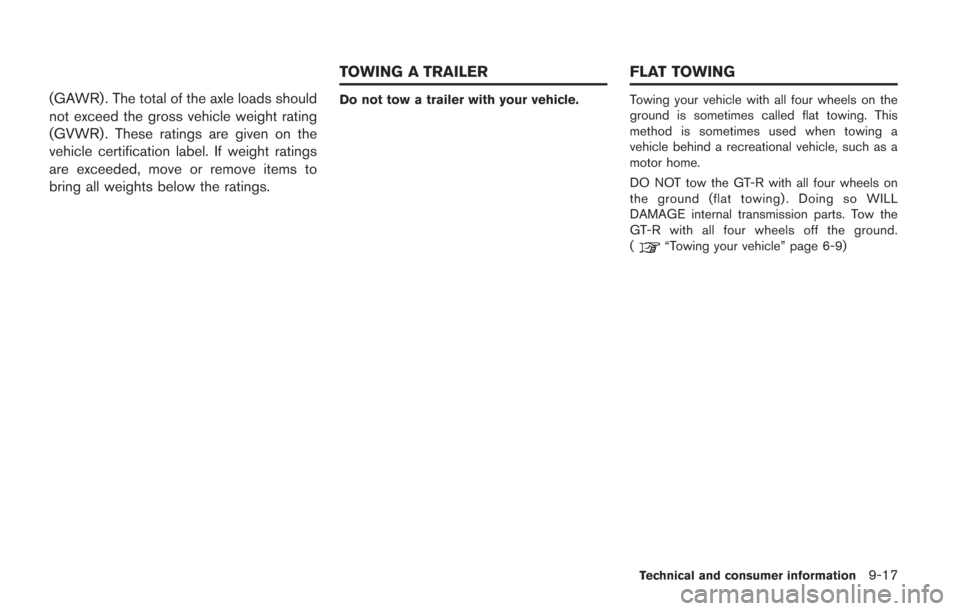
(GAWR). The total of the axle loads should
not exceed the gross vehicle weight rating
(GVWR) . These ratings are given on the
vehicle certification label. If weight ratings
are exceeded, move or remove items to
bring all weights below the ratings.Do not tow a trailer with your vehicle.Towing your vehicle with all four wheels on the
ground is sometimes called flat towing. This
method is sometimes used when towing a
vehicle behind a recreational vehicle, such as a
motor home.
DO NOT tow the GT-R with all four wheels on
the ground (flat towing). Doing so WILL
DAMAGE internal transmission parts. Tow the
GT-R with all four wheels off the ground.
(
“Towing your vehicle” page 6-9)
Technical and consumer information9-17
TOWING A TRAILERFLAT TOWING
Page 337 of 354
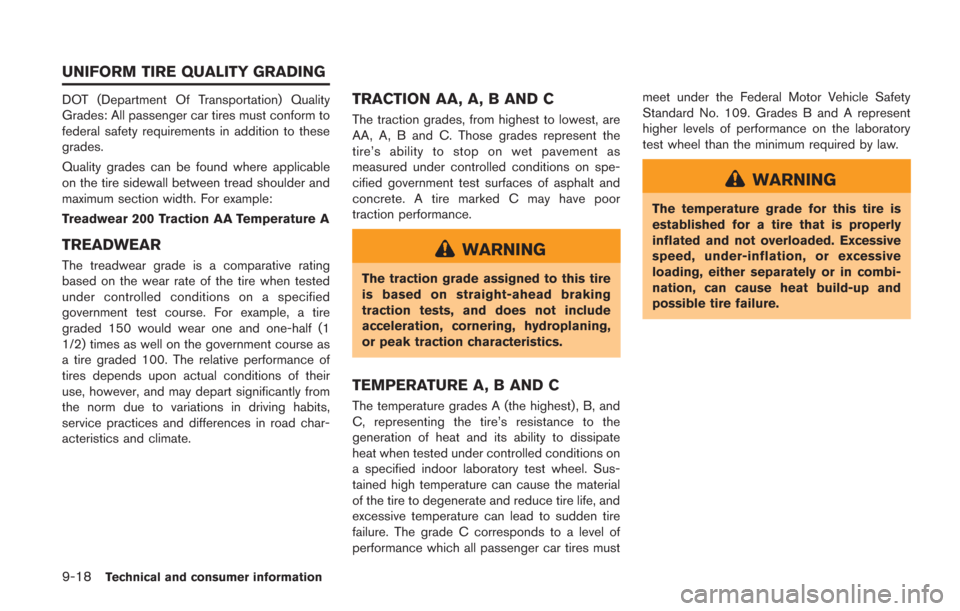
9-18Technical and consumer information
DOT (Department Of Transportation) Quality
Grades: All passenger car tires must conform to
federal safety requirements in addition to these
grades.
Quality grades can be found where applicable
on the tire sidewall between tread shoulder and
maximum section width. For example:
Treadwear 200 Traction AA Temperature A
TREADWEAR
The treadwear grade is a comparative rating
based on the wear rate of the tire when tested
under controlled conditions on a specified
government test course. For example, a tire
graded 150 would wear one and one-half (1
1/2) times as well on the government course as
a tire graded 100. The relative performance of
tires depends upon actual conditions of their
use, however, and may depart significantly from
the norm due to variations in driving habits,
service practices and differences in road char-
acteristics and climate.
TRACTION AA, A, B AND C
The traction grades, from highest to lowest, are
AA, A, B and C. Those grades represent the
tire’s ability to stop on wet pavement as
measured under controlled conditions on spe-
cified government test surfaces of asphalt and
concrete. A tire marked C may have poor
traction performance.
WARNING
The traction grade assigned to this tire
is based on straight-ahead braking
traction tests, and does not include
acceleration, cornering, hydroplaning,
or peak traction characteristics.
TEMPERATURE A, B AND C
The temperature grades A (the highest), B, and
C, representing the tire’s resistance to the
generation of heat and its ability to dissipate
heat when tested under controlled conditions on
a specified indoor laboratory test wheel. Sus-
tained high temperature can cause the material
of the tire to degenerate and reduce tire life, and
excessive temperature can lead to sudden tire
failure. The grade C corresponds to a level of
performance which all passenger car tires mustmeet under the Federal Motor Vehicle Safety
Standard No. 109. Grades B and A represent
higher levels of performance on the laboratory
test wheel than the minimum required by law.
WARNING
The temperature grade for this tire is
established for a tire that is properly
inflated and not overloaded. Excessive
speed, under-inflation, or excessive
loading, either separately or in combi-
nation, can cause heat build-up and
possible tire failure.
UNIFORM TIRE QUALITY GRADING
Page 339 of 354
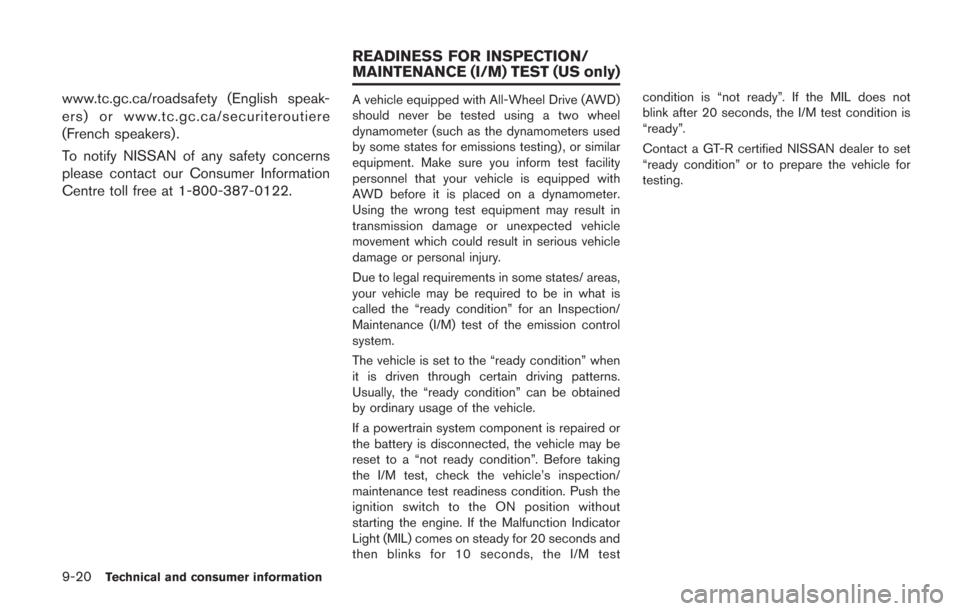
9-20Technical and consumer information
www.tc.gc.ca/roadsafety (English speak-
ers) or www.tc.gc.ca/securiteroutiere
(French speakers).
To notify NISSAN of any safety concerns
please contact our Consumer Information
Centre toll free at 1-800-387-0122.A vehicle equipped with All-Wheel Drive (AWD)
should never be tested using a two wheel
dynamometer (such as the dynamometers used
by some states for emissions testing), or similar
equipment. Make sure you inform test facility
personnel that your vehicle is equipped with
AWD before it is placed on a dynamometer.
Using the wrong test equipment may result in
transmission damage or unexpected vehicle
movement which could result in serious vehicle
damage or personal injury.
Due to legal requirements in some states/ areas,
your vehicle may be required to be in what is
called the “ready condition” for an Inspection/
Maintenance (I/M) test of the emission control
system.
The vehicle is set to the “ready condition” when
it is driven through certain driving patterns.
Usually, the “ready condition” can be obtained
by ordinary usage of the vehicle.
If a powertrain system component is repaired or
the battery is disconnected, the vehicle may be
reset to a “not ready condition”. Before taking
the I/M test, check the vehicle’s inspection/
maintenance test readiness condition. Push the
ignition switch to the ON position without
starting the engine. If the Malfunction Indicator
Light (MIL) comes on steady for 20 seconds and
then blinks for 10 seconds, the I/M testcondition is “not ready”. If the MIL does not
blink after 20 seconds, the I/M test condition is
“ready”.
Contact a GT-R certified NISSAN dealer to set
“ready condition” or to prepare the vehicle for
testing.
READINESS FOR INSPECTION/
MAINTENANCE (I/M) TEST (US only)